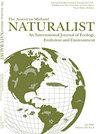Oxbow Restorations for Topeka Shiner (Notropis topeka) Recovery: Defining Success
IF 0.6
4区 环境科学与生态学
Q4 Agricultural and Biological Sciences
引用次数: 2
Abstract
Abstract. Within the Great Plains region of North America, oxbow wetlands were lost as streams were channelized and straightened to allow for agricultural use of the landscape. Topeka Shiner, which rely on these oxbow wetlands, have declined in abundance, currently occupy 20% of their historical geographic range, and are now an endangered species. A large emphasis has been placed on restoring oxbow wetlands to recover Topeka Shiner populations. As the number of oxbow restorations has increased, so has the number of monitoring projects focused on these habitats. Currently, conservation practitioners rely on the presence of Topeka Shiner to determine the success of an oxbow restoration. Given the rarity of the species, this method is likely ineffective. Within this study we attempt to create a model that can be used to determine the success of an oxbow restoration that will benefit the Topeka Shiner without relying on the presence of the species in the wetland. We used multiple fish community metrics and modelling strategies to determine the best model for predicting Topeka Shiner CPUE and presence/absence within oxbows. We determined that the top models were ineffective at predicting Topeka Shiner CPUE and presence/absence. Our findings illustrate the random nature by which fish communities become established within oxbows, and the island-like nature of oxbows in terms of how fish communities may become established and change over time. These findings indicate that the success of oxbow restoration for Topeka Shiner needs to be defined at a larger scale than for individual oxbows. Furthermore, our findings corroborate the inability of previous studies to determine reproducible associations of Topeka Shiner with various fish community metrics.牛轭修复托皮卡Shiner(Notropis Topeka)恢复:定义成功
摘要在北美大平原地区,牛轭湿地随着河流的渠化和拉直而消失,以允许农业利用这一景观。依赖于这些牛轭湿地的托皮卡雪纳的数量已经减少,目前只占其历史地理范围的20%,现在是濒临灭绝的物种。一个很大的重点放在恢复牛轭湿地,以恢复托皮卡夏纳种群。随着牛轭恢复数量的增加,关注这些栖息地的监测项目的数量也在增加。目前,保护从业者依靠托皮卡夏纳的存在来确定牛轭恢复的成功。考虑到这种物种的稀有性,这种方法可能是无效的。在这项研究中,我们试图创建一个模型,可以用来确定牛轭恢复的成功,这将使托皮卡夏纳河受益,而不依赖于湿地中物种的存在。我们使用多种鱼类群落指标和建模策略来确定预测Topeka Shiner CPUE和牛弓内存在/不存在的最佳模型。我们确定顶级模型在预测托皮卡夏纳CPUE和出席/缺席方面是无效的。我们的研究结果说明了鱼类群落在牛轭内建立的随机性,以及鱼类群落如何随着时间的推移而建立和变化的海岛性质。这些发现表明,托皮卡夏纳的牛弓修复成功需要在更大的范围内定义,而不是单个牛弓。此外,我们的研究结果证实了以前的研究无法确定托皮卡夏纳与各种鱼类群落指标的可重复性关联。
本文章由计算机程序翻译,如有差异,请以英文原文为准。
求助全文
约1分钟内获得全文
求助全文
来源期刊

American Midland Naturalist
环境科学-生态学
CiteScore
1.20
自引率
0.00%
发文量
38
审稿时长
18-36 weeks
期刊介绍:
The American Midland Naturalist has been published for 90 years by the University of Notre Dame. The connotations of Midland and Naturalist have broadened and its geographic coverage now includes North America with occasional articles from other continents. The old image of naturalist has changed and the journal publishes what Charles Elton aptly termed "scientific natural history" including field and experimental biology. Its significance and breadth of coverage are evident in that the American Midland Naturalist is among the most frequently cited journals in publications on ecology, mammalogy, herpetology, ornithology, ichthyology, parasitology, aquatic and invertebrate biology and other biological disciplines.
 求助内容:
求助内容: 应助结果提醒方式:
应助结果提醒方式:


